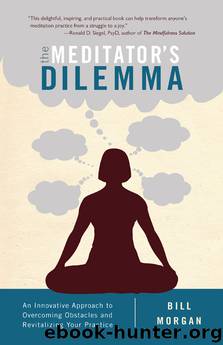The Meditator's Dilemma by Bill Morgan

Author:Bill Morgan
Language: eng
Format: epub
Publisher: Shambhala
Only a tranquil mind is able to hold itself aloft in the light of contemplation.
—Pope Gregory I
9
CONCENTRATION BLUES
A FEW YEARS AGO, I had the privilege of participating in a four-month retreat with the Burmese teacher Pa-Auk, one of the foremost masters of what is called “concentration meditation,” or “concentration practice.” I figured that I would make progress rather quickly. After all, I had been practicing meditation for many years. However, my first few weekly interviews with him were brief and humbling. I would give a brief report of my meditations. He would then smile, cock his head, and say, “Concentration still weak.” End of interview. Finally, after more than two months of following the flow of sensations of the breath at the tip of my nose, the only technique offered, I went before the master. I told him there was only the slightest wavering of attention during a three-hour period of meditation. I felt confident that he would be pleased with my report. Pa-Auk paused and smiled. He pointed to his nose, still smiling, and said, “No wavering.” He looked directly at me, no longer smiling, and repeated, in a sober, sincere voice, “No wavering.”
Concentration practice invariably opens a can of worms for Western practitioners. The word evokes cognitive strain and will-power, tightening and narrowing the field of attention and holding it there. I am reminded of the famous Rodin sculpture, The Thinker: chin on fist, brow furrowed, the essence of intense focus. For Westerners this sculpture embodies the archetype of concentration. However, such an effortful, strained approach is counterproductive for all manner of contemplative and meditation practices.
In addition, it is easy to fall into a frustrating pass/fail relationship with concentration practice. The instruction is clear and leaves no opportunity for reframing: stay with the object of attention. No other experience that arises during the practice, however marvelous it may seem, is acceptable. Pa-Auk was only interested in whether my attention stayed with the flow of sensations of the breath. Nothing else mattered. No cookies. No other measure of progress. No wavering.
Why Bother with Concentration?
Stability and calm, the underpinnings of insight, are the essential qualities cultivated in concentration practice. Stability arises when the attention can settle and focus. Until then, it is unable to gaze steadily at the workings of the mind. Without stability, one’s focus is like that of a handheld video camera: the image is constantly shifting, and it is difficult to establish clear focus. We do not need this level of stability when dealing with the contents of the mind, with our stories. To look more carefully into the underlying, moment-to-moment processes at work in the mind, however, requires another level of refinement in attention.
The establishing of deep calm is equally essential. As concentration matures, the mind begins to move away from its predominant obsession with thought and begins to focus on the flow of sensory experience, most commonly the sensations of the breath as it makes contact with the nostrils. With further progress, the mind begins to rest in the flow of physical sensations.
Download
This site does not store any files on its server. We only index and link to content provided by other sites. Please contact the content providers to delete copyright contents if any and email us, we'll remove relevant links or contents immediately.
Inner Engineering: A Yogi's Guide to Joy by Sadhguru(6633)
The Power of Now: A Guide to Spiritual Enlightenment by Eckhart Tolle(5544)
Fear by Osho(4619)
Ikigai by Héctor García & Francesc Miralles(4044)
The Art of Happiness by The Dalai Lama(4009)
The Ultimate Bodybuilding Cookbook by Kendall Lou Schmidt(3854)
Yoga Therapy by Mark Stephens(3668)
The Little Book of Hygge by Meik Wiking(3515)
The Healing Self by Deepak Chopra(3405)
Why Buddhism is True by Robert Wright(3372)
The Hatha Yoga Pradipika (Translated) by Svatmarama(3184)
Being Aware of Being Aware by Rupert Spira(3170)
Shift into Freedom by Loch Kelly(3098)
Wild Words from Wild Women by Stephens Autumn(3041)
Work Clean by Dan Charnas(3006)
Happiness by Matthieu Ricard(2959)
More Language of Letting Go: 366 New Daily Meditations by Melody Beattie(2941)
Yoga Body & Mind Handbook by Jasmine Tarkeshi(2810)
Why I Am Not a Feminist by Jessa Crispin(2666)
